Six Captive Orphaned Gorillas Move One Step Closer to Freedom
By Gorilla Doctors Staff on Tuesday, July 26th, 2011 in Uncategorized.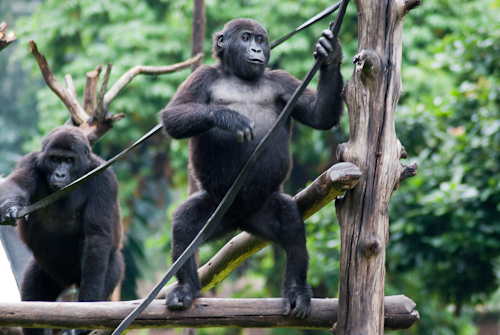 Grauer’s orphans in Rwanda.PRESS RELEASE
Grauer’s orphans in Rwanda.PRESS RELEASEJuly 25, 2011
Musanze, Rwanda – In a remarkable feat of collaboration between the wildlife authorities of the Democratic Republic of Congo (DRC) and Rwanda and multiple conservation organizations, six Grauer’s gorilla orphans were successfully moved this past weekend from a small temporary housing facility in Rwanda to a lush new sanctuary in the DRC. The complicated move, which necessitated that all six gorillas be sedated, driven two hours to an airstrip in the DRC, and then helicoptered individually to their new home, was a crucial step forward for the gorillas.
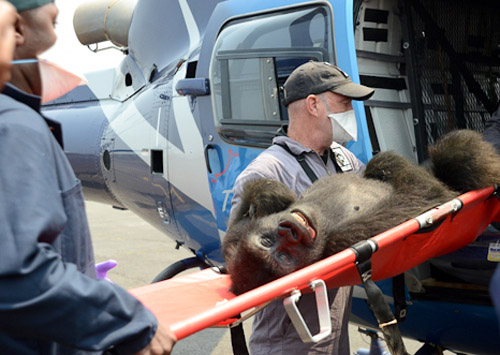 Dr. Mike Cranfield helps load one of the orphans into a helicopter.
Dr. Mike Cranfield helps load one of the orphans into a helicopter.Stakeholders hope the orphan gorillas will be able to learn the survival skills necessary for their release into the wild. Ranging in age from 5 to 9, they were captured in the DRC as infants by poachers and likely saw their families killed in the process. After being confiscated by authorities, the orphans were sent to Rwanda for caretaking until an appropriate facility was built in the DRC. They will be joining six younger orphans at their newly constructed home called GRACE, which encompasses 350 acres of forest.
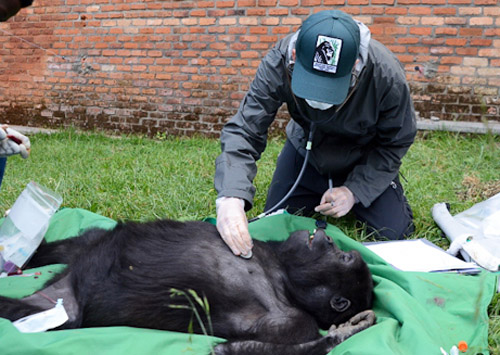 Dr. Jan Ramer performs a health check.The Mountain Gorilla Veterinary Project (MGVP), which aided in the confiscation of the orphans and cared for them at the Rwandan facility along with the Dian Fossey Gorilla Fund International (DFGFI), took responsibility for sedating the gorillas and monitoring their health throughout the move. Female gorillas Pinga, Serufuli, and Tumaini were each darted with a sedative on Saturday morning and, after undergoing a brief health check, were loaded into crates for shipping. At the Goma, DRC, airport, the orphans flew one by one in the company of a veterinarian to GRACE. The next day, females Itebero and Dunia and male Ntabwoba repeated the process. After a period of adjustment, the six new arrivals will be integrated the other orphans at GRACE.
Dr. Jan Ramer performs a health check.The Mountain Gorilla Veterinary Project (MGVP), which aided in the confiscation of the orphans and cared for them at the Rwandan facility along with the Dian Fossey Gorilla Fund International (DFGFI), took responsibility for sedating the gorillas and monitoring their health throughout the move. Female gorillas Pinga, Serufuli, and Tumaini were each darted with a sedative on Saturday morning and, after undergoing a brief health check, were loaded into crates for shipping. At the Goma, DRC, airport, the orphans flew one by one in the company of a veterinarian to GRACE. The next day, females Itebero and Dunia and male Ntabwoba repeated the process. After a period of adjustment, the six new arrivals will be integrated the other orphans at GRACE.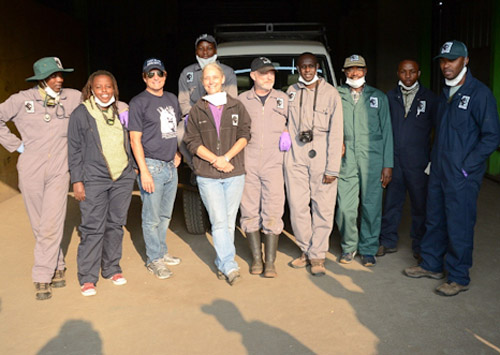 The MGVP orphan move team.“GRACE will give these gorillas the opportunity they deserve to be in a large forest enclosure where they can learn to be gorillas again,” says Dr. Jan Ramer, Regional Veterinary Manager of MGVP. “This is a huge success for all for all of the partners. We’ve been working with these gorillas since they were traumatized and sick babies – how wonderful that they are now healthy and happy, and will soon be roaming the forest in a secure enclosure.”
The MGVP orphan move team.“GRACE will give these gorillas the opportunity they deserve to be in a large forest enclosure where they can learn to be gorillas again,” says Dr. Jan Ramer, Regional Veterinary Manager of MGVP. “This is a huge success for all for all of the partners. We’ve been working with these gorillas since they were traumatized and sick babies – how wonderful that they are now healthy and happy, and will soon be roaming the forest in a secure enclosure.”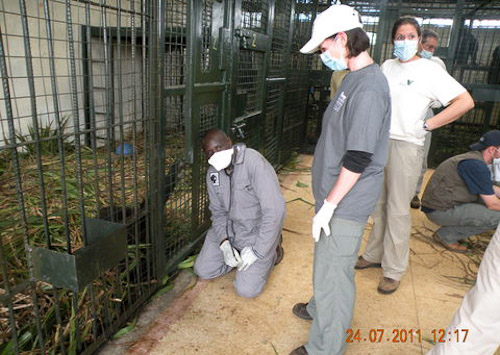 Dr. Jean-Felix Kinani watches as the orphans recover from sedation at GRACE’s indoor facility.The GRACE (Gorilla Rehabilitation and Conservation Education) center is the first facility of its kind in east central Africa, with room for up to 30 young gorillas to live in species-typical groups and roam through natural habitat, in the hope of eventually reintroducing them to the wild. The site was donated by the Tayna Center for Conservation Biology (TCCB) and is located just adjacent to the Tayna Nature Reserve, near the village of Kasugho, DRC.
Dr. Jean-Felix Kinani watches as the orphans recover from sedation at GRACE’s indoor facility.The GRACE (Gorilla Rehabilitation and Conservation Education) center is the first facility of its kind in east central Africa, with room for up to 30 young gorillas to live in species-typical groups and roam through natural habitat, in the hope of eventually reintroducing them to the wild. The site was donated by the Tayna Center for Conservation Biology (TCCB) and is located just adjacent to the Tayna Nature Reserve, near the village of Kasugho, DRC.GRACE was initiated by DFGFI at the urging of the Congolese national park service (ICCN), with funding from the U.S. Fish and Wildlife Service, and design and construction assistance from Disney’s Animal Programs. The Fossey Fund and the Walt Disney Company are the first of several partners that will continue long-term funding and operation of the center.
The helicopter transfer of the six orphaned gorillas from Kinigi, Rwanda, to GRACE was funded principally by the International Fund for Animal Welfare (IFAW). Organized by the Fossey Fund, the move also includes substantial assistance from the Rwanda Development Board (RDB), ICCN, Disney’s Animal Programs, MGVP, and Tropicair.
About Grauer’s Gorillas
One of four different gorilla subspecies found in Africa, Grauer’s or eastern lowland gorillas (Gorilla beringei graueri) are closely related to mountain gorillas (Gorilla beringei beringei), but prefer lower altitude forests and have less fur. Grauer’s gorillas only live in the lowland forests of eastern DRC including parts of Kahuzi-Biega, Virunga, and Maiko national parks. Due to the instability of the regions where Grauer’s gorillas live, it is difficult to estimate the population’s size, but there may be several thousand individuals. Unfortunately, this lack of security makes Grauer’s gorillas easy targets for poachers hoping to profit from the illegal wildlife trade. Every year, ICCN and other conservation organizations investigate dozens of reports of Grauer’s gorillas being held illegally. Only a fraction of these investigations result in a successful confiscation.
About the Mountain Gorilla Veterinary Project
The Mountain Gorilla Veterinary Project, a U.S.-based nonprofit organization, is dedicated to saving mountain gorilla lives. With so few animals left in the world today, the organization believes it is critical to ensure the health and well being of every individual possible. The organization’s international team of veterinarians, the Gorilla Doctors, is the only group providing wild mountain gorillas with direct, hands-on care. The Mountain Gorilla Veterinary Project partners with the UC Davis Wildlife Health Center to advance One Health strategies for mountain gorilla conservation. MGVP also intervenes to save Grauer’s gorillas when possible. www.gorilladoctors.org
About the UC Davis Wildlife Health Center
The UC Davis Wildlife Health Center, home of the Mountain Gorilla One Health Program and a center of excellence within the School of Veterinary Medicine, is composed of 13 epidemiologists, disease ecologists and ecosystem health clinicians and their staff working at the cutting edge of pathogen emergence and disease tracking in ecosystems. It benefits from the expertise of 50 other participating UC Davis faculty members from many disciplines who are involved in the discovery and synthesis of information about emerging zoonotic diseases (those transmitted between people and animals) and ecosystem health. Its mission is to balance the needs of people, wildlife and the environment through research, education and service. www.vetmed.ucdavis.edu/whc.
Media Contact
Molly Feltner
Communications Officer
Mountain Gorilla Veterinary Project
mollyfeltner@gmail.com
+1-857-719-9258
Please consider supporting MGVP by making a secure online donation. Every dollar you give goes to directly supporting our gorilla health programs and One Health initiative. Thank you for your generosity.
For the most up-to-date information about the Gorilla Doctors, “like” our Facebook page. You’ll find gorilla health reports, news items, photos, videos, and links to related content.


 Donate
Donate